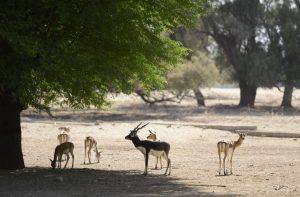
Mangla Dam, Sixth-largest dam in the world.
October 26, 2021
Passu Cones also known as Passu Cathedral is the highest point.
October 26, 2021
Lal Suhanra National Park is the largest park in the South Asian region located in Bahawalpur district of Punjab, Pakistan. The park is a synthesis of forest and desert that spreads over an area of 127,480 acres, out of which 20,974 acres are green land, 101,726 acres are dry land, and 4,780 acres are ponds and lakes. In 1972, the total area of the park was 77480 acres; later on in 1984, 50000 acres of land was further added to it. In 2000, the total area of the park became 162568 acres when 35088 more acres were added to existing land. A survey regarding the transfer of an additional area of 28800 acres has been completed.
The park is home to native fauna & flora species of Cholistan. The Park was established to protect endangered species like Bluebuck, Blackbuck, Chinkara gazelle, and others. Tourists can find a large number of species of animal at Lal Suhanra National Park. There are numerous wildlife animals like deer, bustards, wildcats, and rabbits. It is a breeding ground for a large number of reptiles including Indian Cobra Monitor lizard, Russell’s viper, Wolf Snake, Saw Scaled Viper, John’s Sand Boa, and Spiny Tailed Lizard. The park is home to more than 160 species of birds including the Laggar Falcon, Peregrine Falcon, Houbara, Bustard, Marsh Harrier Griffon Vulture, and many more. There is a beautiful lake named Patisar Lake, located in the center of the park that is a perfect place for bird watching. In the winter season, the lake holds almost 10,000 to 30,000 ducks regularly. A large population of birds of prey has been supported by the park. One of the most famous spots within the park is Lion Safari, which allows the visitors to see lions in their natural habitats. Moreover, the park is home to a pair of Rhinoceros which were gifted from Nepal.
There are tourist huts, Motels, rest houses, watch towers, catching, and camping grounds for tourists and lovers of nature. The government of Punjab is planning to convert Lal Suhanra National Park into an international standard Wildlife Safari Park
